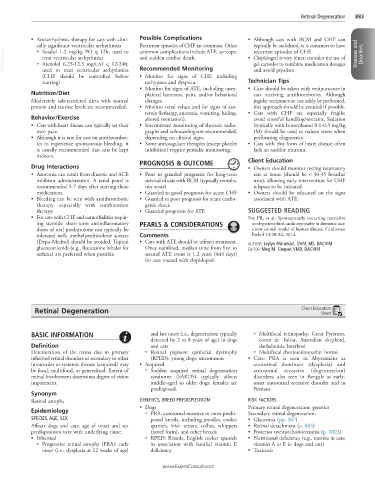Page 1757 - Cote clinical veterinary advisor dogs and cats 4th
P. 1757
Retinal Degeneration 883
• Antiarrhythmic therapy for cats with clini- Possible Complications • Although cats with RCM and CHF can
cally significant ventricular arrhythmias Recurrent episodes of CHF are common. Other typically be stabilized, it is common to have
VetBooks.ir ○ Atenolol 6.25-12.5 mg/CAT q 12-24h; and sudden cardiac death. • Clopidogrel is very bitter; consider the use of Diseases and Disorders
○ Sotalol 1-2 mg/kg PO q 12h; used to
common complications include ATE, syncope,
recurrent episodes of CHF.
treat ventricular arrhythmias
gel capsules to combine medication dosages
Recommended Monitoring
used to treat ventricular arrhythmias
(CHF should be controlled before • Monitor for signs of CHF, including and avoid ptyalism.
starting) tachypnea and dyspnea. Technician Tips
• Monitor for signs of ATE, including unex- • Care should be taken with venipuncture in
Nutrition/Diet plained lameness, pain, and/or behavioral cats receiving antithrombotics. Although
Moderately salt-restricted diets with normal changes. jugular venipuncture can safely be performed,
protein and taurine levels are recommended. • Monitor renal values and for signs of azo- this approach should be avoided if possible.
temia (lethargy, anorexia, vomiting, hiding, • Cats with CHF are especially fragile;
Behavior/Exercise altered mentation). avoid stressful handling/restraint. Sedation
• Cats with heart disease can typically set their • Intermittent monitoring of thoracic radio- (typically with butorphanol 0.1-0.3 mg/kg
own pace. graphs and echocardiogram recommended, IM) should be used to reduce stress when
• Although it is rare for cats on antithrombot- depending on clinical signs. performing diagnostics.
ics to experience spontaneous bleeding, it • Some anticoagulant therapies (except platelet • Cats with this form of heart disease often
is usually recommended that cats be kept inhibition) require periodic monitoring. lack an audible murmur.
indoors.
PROGNOSIS & OUTCOME Client Education
Drug Interactions • Owners should monitor resting respiratory
• Azotemia can result from diuretic and ACE • Poor to guarded prognosis for long-term rate at home (should be < 30-35 breaths/
inhibitor administration. A renal panel is survival of cats with RCM (typically months, min), allowing early intervention for CHF
recommended 5-7 days after starting these not years) relapses to be initiated.
medications. • Guarded to good prognosis for acute CHF • Owners should be educated on the signs
• Bleeding can be seen with antithrombotic • Guarded to poor prognosis for acute cardio- associated with ATE.
therapy, especially with combination genic shock
therapy. • Guarded prognosis for ATE SUGGESTED READING
• For cats with CHF and comorbidities requir- Fox PR, et al: Spontaneously occurring restrictive
ing steroids: short-term antiinflammatory PEARLS & CONSIDERATIONS nonhypertrophied cardiomyopathy in domestic cats:
doses of oral prednisolone can typically be a new animal model of human disease. Cardiovasc
tolerated well; methylprednisolone acetate Comments Pathol 23:28-34, 2014.
(Depo-Medrol) should be avoided. Topical • Cats with ATE should be offered treatment. AUTHOR: Jaylyn Rhinehart, DVM, MS, DACVIM
glucocorticoids (e.g., fluticasone inhaler for Once stabilized, median time from first to EDITOR: Meg M. Sleeper, VMD, DACVIM
asthma) are preferred when possible. second ATE event is 1.2 years (443 days)
for cats treated with clopidogrel.
Retinal Degeneration Client Education
Sheet
BASIC INFORMATION and late onset (i.e., degeneration; typically ○ Multifocal retinopathy: Great Pyrenees,
detected by 2 to 8 years of age) in dogs coton de Tuléar, Australian shepherd,
Definition and cats dachshunds, boerboel
Deterioration of the retina due to primary ○ Retinal pigment epithelial dystrophy ○ Multifocal chorioretinopathy: borzoi
inherited retinal disorders or secondary to other (RPED); young dogs; uncommon • Cats: PRA is seen in Abyssinians as
intraocular or systemic disease (acquired) may • Acquired autosomal dominant (dysplasia) and
be focal, multifocal, or generalized. Extent of ○ Sudden acquired retinal degeneration autosomal recessive (degeneration)
retinal involvement determines degree of vision syndrome (SARDS) typically affects disorders; also seen in Bengals as early-
impairment. middle-aged to older dogs; females are onset autosomal recessive disorder and in
predisposed. Persians
Synonym
Retinal atrophy GENETICS, BREED PREDISPOSITION RISK FACTORS
• Dogs Primary retinal degeneration: genetics
Epidemiology ○ PRA: autosomal recessive in most predis- Secondary retinal degeneration:
SPECIES, AGE, SEX posed breeds, including poodles, cocker • Glaucoma (pp. 387)
Affects dogs and cats; age of onset and sex spaniels, Irish setters, collies, whippets • Retinal detachment (p. 885)
predisposition vary with underlying cause: (novel form), and other breeds • Posterior uveitis/chorioretinitis (p. 1023)
• Inherited ○ RPED: Briards, English cocker spaniels • Nutritional deficiency (e.g., taurine in cats;
○ Progressive retinal atrophy (PRA): early in association with familial vitamin E vitamin A or E in dogs and cats)
onset (i.e., dysplasia at 12 weeks of age) deficiency • Toxicosis
www.ExpertConsult.com

